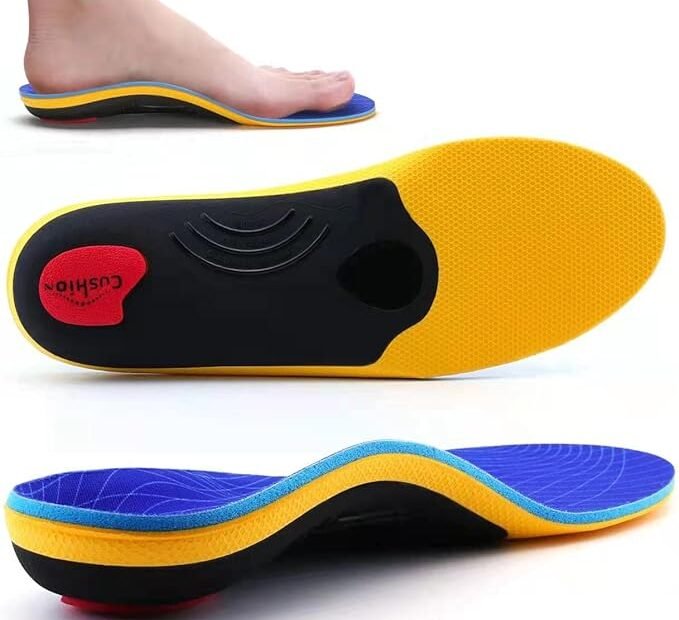Do you feel discomfort or pain in your feet due to high arches? High arches, also known as cavus foot, can cause a range of issues like instability, ankle sprains, and plantar fasciitis. The good news is that orthotics for high arches can help relieve this pain. Orthotics are custom-made shoe inserts designed to support your feet and correct any imbalances in the way you walk or stand. In this blog, we’ll discuss high arches and their impact on your feet. We’ll also take an in-depth look at how orthotics can help alleviate foot pain from high arches. Additionally, we will cover how to choose the right orthotics for your needs and share some success stories of people who have used orthotics to improve their quality of life.
Understanding High Arches
High arches, also referred to as pes cavus, indicate an elevated foot arch causing increased pressure on the heel and metatarsal heads. This condition often results in discomfort, foot pain, plantar fasciitis, back pain, and even shin splints. The rigid arch shape affects shock absorption and weight distribution, leading to the necessity of orthotics for high arches. These specialized shoe insoles are designed to offer superior support and cushioning for day-long comfort, helping to alleviate the impact of high arches on the feet. By providing the right level of support and alignment, orthotics can help mitigate the effects of supination and reduce the risk of issues like achilles tendonitis.
Defining High Arches and their Impact on Feet
High arches, or pes cavus, exhibit a prominent arch that remains evident even when weight is placed on the feet. This foot type often presents with supination, leading to uneven weight distribution, especially on uneven surfaces. High arches are commonly linked to conditions like muscular dystrophy, cerebral palsy, and foot pain, impacting the gait pattern due to the smaller toes and heel bearing the bulk of the body weight. Custom orthotics designed for high arches provide moderate control, effectively supporting the medial arches to alleviate discomfort and improve foot function.

Causes of High Arches
High arches may result from abnormal foot development in childhood, with the arch being higher than normal. Neurological conditions such as cerebral palsy can also lead to this foot condition, affecting the arch structure. Additionally, genetic factors, injuries, or diseases impacting muscle tone may contribute to the development of high arches. Furthermore, conditions affecting the lower extremities, like muscular dystrophy, may also result in high arch formation. Understanding these causes is crucial for effective management and orthotic intervention, enabling tailored solutions to address the specific underlying factors contributing to high arch development.
The Role of Orthotics for High Arches
Orthotic insoles for high arches are crafted to deliver arch support, cushioning, and relief from foot pain. By evenly distributing pressure, these inserts reduce excessive pressure points. Deep heel cups and cradles stabilize the heel, averting pain. Moreover, they provide metatarsal support, lowering the risk of forefoot pain. Addressing the biomechanical issues linked with high arches, orthotic arch support is crucial.
What are Orthotics and How Can They Help?
Orthotics, whether custom-made or off-the-shelf inserts, provide support and cushioning inside shoes. They help correct foot alignment, improve gait, and reduce excessive pressure. Specifically for high arches, orthotics offer shock absorption, alleviate foot pain, and ensure comfortable everyday use of footwear. Orthotic arch support insoles are designed to provide superior support, comfort, and pain relief.
Types of Orthotics Suitable for High Arches
When addressing high arches, custom orthotics are essential as they provide personalized support by conforming to the individual’s foot shape. Semi-rigid orthotic insoles offer a balanced combination of support, cushioning, and shock absorption, addressing the specific needs of high arches. Over-the-counter orthotic arch support inserts provide cost-effective relief for foot pain, catering to individuals seeking affordable solutions. Foam, cushion, and rigid orthotic insoles are designed to meet the comfort and support requirements of high arches, offering various options for personalized relief. Additionally, orthotic inserts for high arches come in different arch types, accommodating the unique foot shapes of individuals for optimal support and comfort.

Choosing the Right Orthotics for High Arches
Selecting suitable orthotics for high arches entails considering the foot arch type and required support. Factors such as arch type, foot pain, support insoles, and heel discomfort should influence the choice of orthotic inserts. Critical evaluation of orthotic arch support, cushioning, shock absorption, and pressure relief is essential for optimal comfort. Effective high arch support is imperative in orthotics for high arches to address the specific support needs of the foot arches. Additionally, orthotics for high arches should offer relief for plantar fasciitis, metatarsalgia, and lower back pain.
Factors to Consider When Selecting Orthotics
When selecting orthotic support for high arches, it’s crucial to determine the arch type. Look for insoles with heel cup support, cushioning, and shock absorption to provide day-long comfort. Consider factors like everyday use and pain relief, and look for orthotics that offer metatarsal support and forefoot relief for added comfort. Ensure that the orthotics address foot pain, flat feet, and arch pain, offering effective support and comfort. By considering these factors, you can choose orthotics that cater to the specific needs of high arches without compromising on support or comfort.
Popular Brands and Products in the Market
When it comes to orthotic support for high arches, there are several popular brands and products available in the market. Powerstep insoles offer superior arch support, cushioning, and pain relief for the feet. Superfeet orthotic inserts provide a deep heel cup, arch support, and shock absorption features. Renowned brands offer orthotics catering to diverse arch shapes and foot support needs. These orthotic insoles assure quality, comfort, and pain relief for foot conditions, available in various designs, materials, and arch support levels, enhancing day-long comfort and free returns. The packaging of these products focuses on odor control, making them suitable for all types of footwear.

Success Stories of People Using Orthotics for High Arches
Individuals with high arches have shared their success stories after using orthotic inserts, experiencing remarkable relief from foot pain. The impact of orthotic insoles on conditions like plantar fasciitis and arch pain has been profound, providing much-needed support and comfort. Additionally, the testimonials highlight how orthotic arch support not only alleviated deep heel pain and back pain but also improved overall foot health. Users expressed their satisfaction with the benefits of orthotic insoles, emphasizing their everyday use for high arch feet. These success stories underscore the effectiveness and day-to-day comfort that orthotics offer, making them an essential solution for individuals with high arches.
Durable Construction
When choosing orthotics for high arches, it’s essential to consider their construction. Durable materials like EVA foam or silicone gel provide the necessary support and cushioning for foot pain relief. The thickness of the orthotics also plays a crucial role in ensuring comfortable fit inside your shoes. Moreover, these orthotics not only alleviate foot pain but can also improve posture and relieve pain in other areas such as the knees and lower back. It’s advisable to consult a healthcare professional to determine the best type of orthotics tailored to your specific needs.

How Often Should Orthotics be Replaced?
To ensure continued pain relief and effectiveness, it’s important to know when to replace orthotic inserts for high arches. Look out for signs like worn-out cushioning or reduced support. The durability of orthotic insoles impacts their long-term foot pain relief. Consider replacing them every 6-12 months for optimal results.
Can Orthotics help prevent foot pain associated with high arches?
Orthotics can be helpful in preventing foot pain related to high arches. They provide support and cushioning, alleviating pressure on the arch. Custom-made orthotics are recommended for individuals with high arches. Consult a podiatrist or specialist to determine if orthotics are suitable for you.
Are there any drawbacks to using Orthotics for high arches?
Orthotics for high arches can provide relief from foot pain, but there are some drawbacks to consider. They can be expensive and may not be covered by insurance. Additionally, some people may find them uncomfortable initially, although they often adjust over time. It’s important to consult with a podiatrist or healthcare professional before using orthotics for high arches.
What should I expect when I first start using orthotics for high arches?
When you first start using orthotics for high arches, it’s important to be patient. You may experience some initial discomfort or soreness in your feet or legs as you adjust. However, over time, the orthotics should provide relief from foot pain and improve your overall foot function. Follow the instructions of your podiatrist or healthcare provider for best results.
Can custom-made orthotics be more effective than off-the-shelf ones for high arches?
Custom-made orthotics can provide better support and alignment for high arches compared to off-the-shelf ones. Designed to fit the unique shape of your foot, they offer enhanced effectiveness in relieving foot pain. Consulting a podiatrist can help determine if custom-made orthotics are necessary for your specific needs.
Conclusion
If you are suffering from foot pain caused by high arches, orthotics can provide much-needed relief. Orthotics are custom-made inserts that help correct the alignment and support of your feet, reducing pain and discomfort. There are different types of orthotics available for high arches, so it’s important to choose the right one for your specific needs. Consider factors such as material, cushioning, and arch support when selecting orthotics. It’s also recommended to replace your orthotics regularly to ensure they continue to provide the necessary support. Many people have experienced success with orthotics, finding relief from foot pain and improved overall comfort. Don’t let high arches hold you back – try orthotics and take the first step towards pain-free feet.
I hope you found this article helpful and please feel free to comment and share.
You might find the following blogs also helpful: plantar fasciitis gel sleeve and plantar fascia compression sleeve.
Thanks for reading!
 | Tracy J. Founder, The heel GP |
